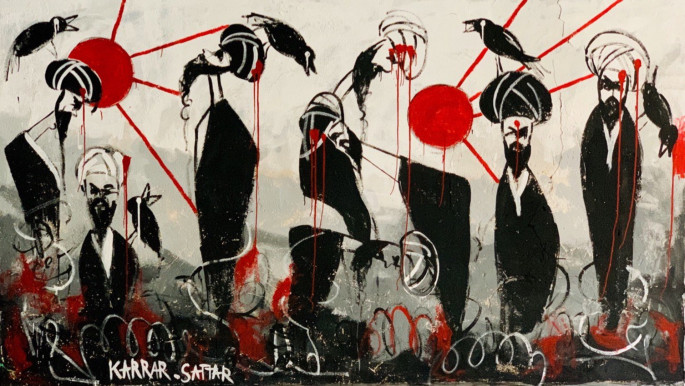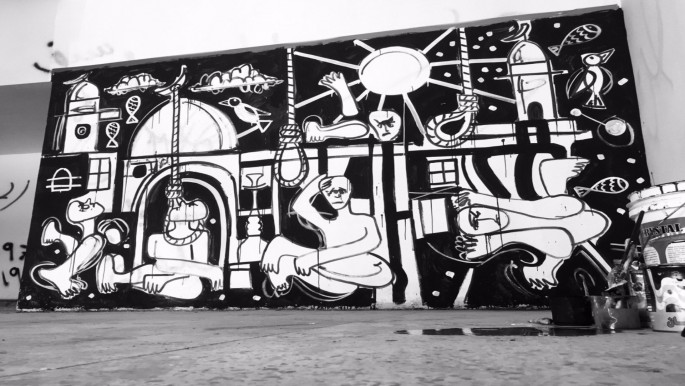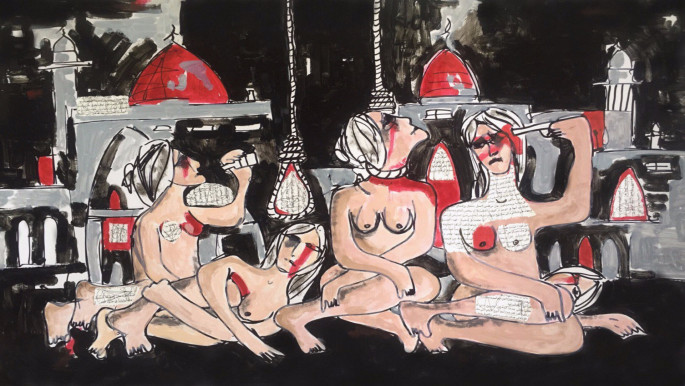Surrealist painter captures Iraq's descent into the abyss of corruption and decay
Murals painted not by famed top-brass artists, but the country's youth, lit-up cities dulled and disfigured beneath corruption, decay, and before that, years of urban combat.
Youth artists embellished Saadoun underpass in downtown Baghdad with murals and watchwords that offer a visual commentary on societal hardships and the state's undiminished appetite for violence against protesters.
An underpass that society scarcely frequented was transformed into an outdoor gallery where families and youth gather, reminiscent of Germany's Berlin Wall or Belfast's Islandbawn street.
Images adorning city walls and tunnels are not platitudinous. They speak to a matter-of-factness, from the violence women endure to the cloud of death that hovers above households and extreme poverty.
Iraq's descent into the abyss of corruption and decay is best captured by self-taught artist Karrar Sattar, whose surrealist murals capture religiosity, or rather its paradox, and bellicosity in the new Iraq.
"Pretty walkways and landscapes carry no appeal for me," the 23-year-old told The New Arab. "My canvases express the reality we [Iraqis] live in," a style that combines surrealism and expressionism.
 |
Iraq's October uprising against a corrupt elite brightened a monochrome urban landscape and put colour back into Baghdad's cheeks |  |
Unlike household artistic names in Iraq, Sattar is not university educated. The young artist is impressively self-taught and has cultivated a visual language that is distinctively his own.
Sattar's most recognised mural in Baghdad depicts a group of turbaned men - facially disfigured - whose bodies and religious garb is being gnawed at by crows, while crimson red suns rise-up behind them.
"Red signifies danger and the crows - I personally like them - but they represent a bad omen in [Iraqi] culture," Sattar explained. The barbed wire in the foreground, he added, was added as a mark of repression.
 |
|
| 'Red signifies danger, and the crows represent a bad omen in [Iraqi] culture'. [Karrar Sattar] |
Like a photojournalist, what moves Sattar is the urgency to document cataclysmic events in real time, at a national and personal level.
"Prior to the revolution, news about a young girl's suicide death would frequently reach us. It's these moments that compel me to translate reality in art," the muralist said.
"When the revolution erupted, I hesitated to participate at first," he said, citing financial circumstances. "Once donations poured in and with a little encouragement from friends," Sattar joined the ranks of October protesters.
Since October last year, Sattar has produced two large murals and countless works that grieve for the 600 protesters unjustifiably killed by security forces.
 |
Youth artists embellished downtown Baghdad with murals and watchwords that offer a visual commentary on societal hardships and the state's undiminished appetite for violence |  |
Inside Sattar's work lives a distinctive darkness and haunting sadness that echoes the lived experiences of the nation at large. Oppressor and the oppressed feature side by side in some pieces and alone in others.
Implicit in his works is a critique of what Sattar describes as "indoctrinated Iraqi society", large swathes of whom are swayed by men of faith and their political partners in power, Sattar explained. "They", he said referring to Iraq's religious men, "are responsible for our suffering".
"The revolution grew in opposition to them," he said, but expressed cynicism at the likelihood of nationwide change following Mustafa al-Kadhimi's election as prime minister on 6 May, 2020.
The first thing he did was to authorise the retirement of former premier Adel Abdul Mahdi and his ministerial cabinet, Sattar said. "What about the protesters killed under his watch?"
 |
|
| Motifs across Sattar's work provoke onlookers to question the status of their society. [Karrar Sattar] |
"The revolution remains widely opposed to people that benefit from the [political] system. Why would they back change," Sattar rued. "Attitudes have to change first," he said.
Sattar translates this message in an untitled 50 x 40 canvas that features a headless man performing a lobotomy on his head which, once cracked open, is filled with clerics and bladed chains commonly used in rituals of self-flagellation.
Another piece titled 'Revolutionary Icon' depicts 26-year-old activist Safaa al-Saray that security forces shot in the head with a tear gas canister. The manner in which he was killed elevated him to the rank of national hero.
 |
Hollowed eye sockets, the hangman's noose, floating fish, clerics, blades, anguished lovers, bloodied women and self-harm are recurrent motifs across Sattar's portfolio, provoking onlookers to question the status of their society |  |
Pouring out of one side of Sarray's face is a bouquet of motifs - Tuk Tuks, Tahrir Square's Turkish Restaurant, protesters, pencils and the image of a faceless woman - presumably Saray's mother - dressed in a traditional Jubba, is stitched in place of his heart.
Sattar's work offers important meditations on the events that occurred which helped "many youth, previously ashamed by the powerlessness of their situation, to find themselves," he said.
The surrealist and expressionist artist confronts what few dare to in a country where creative thought is stifled and imaginations censored.
 |
|
| The artist confronts what few dare to in a country where creative thought is stifled and imaginations censored. [Karrar Sattar] |
"We want a secular state where our freedom of expression is respected, and where people have the choice of praying at the mosque or drinking at the bar," Sattar said.
Hollowed eye sockets, the hangman's noose, floating fish, clerics, blades, anguished lovers, bloodied women and self-harm are recurrent motifs across Sattar's portfolio, provoking onlookers to question the status of their society and themselves.
Having lost friends to violent clashes between unarmed protesters and riot police, Sattar told The New Arab that he is cautious of where he promotes his work, fearing blow back against himself and family.
 |
Most importantly, we didn't stay silent, even if our only success is to set an example for successive generations, that's enough - Karrar Sattar |
 |
Civilian defiance, largely Shia, against a government that has wasted and embezzled billions of dollars and failed its citizens continues to inspire Sattar's artistic inventions, but the artist is unsure of whether the revolution can withstand the test of the Covid-19 pandemic and the state's voracious appetite for violence.
"The revolution has continued but the turnout is far less than before because of the coronavirus," Sattar explained. "Even if this results in a temporary pause, we expect that protests will return more strongly in the foreseeable future".
"Most importantly, we didn't stay silent," Sattar added, "even if our only success is to set an example for successive generations, that's enough". However, everything in Sattar's mind, the continuation and success of the October Revolution, hinges on whether societal attitudes can change.
As the aspiring artist wrote recently on social media, citing Russian novelist Fyodor Dostoyevsky, "the lack of money doesn't kill me, the humiliation does".
Nazli Tarzi is a freelance British-Iraqi journalist, specialising in Middle East politics, with a particular interest in Iraqi affairs.
Follow her on Twitter: @NazliTarzi





 Follow the Middle East's top stories in English at The New Arab on Google News
Follow the Middle East's top stories in English at The New Arab on Google News


